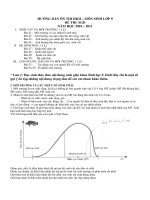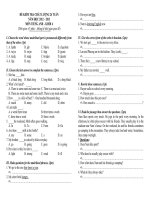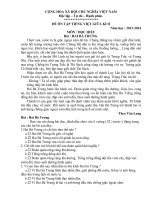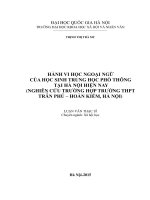- Trang chủ >>
- Lớp 8 >>
- Giáo dục công dân
Nội dung ôn tập giữa kỳ 2 môn Tiếng Anh lớp 12 Trường THPT Trần Phú - Hoàn Kiếm năm 2021-2022 | Tiếng Anh, Lớp 12 - Ôn Luyện
Bạn đang xem bản rút gọn của tài liệu. Xem và tải ngay bản đầy đủ của tài liệu tại đây (400.19 KB, 4 trang )
SỞ GIÁO DỤC VÀ ĐÀO TẠO HÀ NỘI
TRUONG THPT TRAN PHU-HOAN KIEM
NOI DUNG ON TAP KIEM TRA
GIUA HOC KI II
Môn: Tiếng Anh
Lớp: 12
Năm học: 2021-2022
A. REVIEW UNIT 6+ 7:
I. Vocabulary:
Endangered Species
Artificial intelligence
II. Grammar:
The future perfect
Double comparatives
The active and passive causatives
III. Prounciation:
Sentence stress
Linking vowel to vowel
IV. Writing:
Writing an essay aout the advantages and disadvantages of intelligent machines
Write a report about an endangered species
B. TYPES OF EXERCISES:
I. PRONUNCIATION
1. Choose the word whose underlined part is pronounced differently from the others. (2 questions)
2. Choose the word whose main stress is placed differently from the others. (2 questions)
I. VOCABULARY AND GRAMMAR (12 questions)
III. Synonym / Antonym (4 questions)
IV. Correct mistakes (3 questions)
V. Reading
1. Gap filling: (5 questions)
2. Reading text : (7 questions)
VI. Writing:
1. Rewrite the sentences: (3 questions)
2. Combine the sentences: (2 questions)
C. PRACTICE TEST:
I. Mark the letter A, B, C, or D to indicate the word whose underlined part differs from the other three
in pronunciation in each of the following questions.
Question 1. A. survival
B. natural
C. vulnerable
D. agricultural
Question 2. A. endangered
B. died
C. evolved
D. stopped
II. Mark the letter A, B, C or D to indicate the word that differs from the other three in the position of
primary stress in each of the following questions.
Question 3. A. intelligence
B. diversity
C. automated
D. exterminate
Question 4. A. navigation
B. application
C. incredible
D. artificial
III. Mark the letter A, B, C, or D to indicate the underlined part that needs correction in each of the
following sentences.
Question 5. Artificial intelligence is also known for machine intelligence.
A
B
C
D
Question 6. Artificial intelligence (Al) is the ability of a digital computer to perform tasks commonly
A
B
C
associated with intelligence beings.
D
Question 7. Many nations protect endangered species by forbidding hunting, to restrict land
A
B
C
development and creating preserves.
D
IV. Mark the letter A, B, C, or D to indicate the correct answer to each of the following sentences.
Question 8. Last month, we had our representatives
a conference on environmental pollution.
A. to attend
B. attend
C. attending
D. attended
Question 9. Global accountancy firm Deloitte has been hitina___ that compromised the data of a small
number of its clients.
A. cyber-attack
B. crisis
C. battlefield
D. network
Question 10. Robert and Cyber are talking with each other about robots. Complete the conversation.
Robert: "Do you think robots could ever control the world?" - Cyber: “
”
A. Oh, no. None of such a thing.
B. No need to ask, just help yourself.
C. Are you saying that?
D. It'll take a while, but I'm working on it.
Question 11. Before computers were common in the classroom, teachers _ in front of the room and talk
endlessly about a subject.
A. would have to stand up
B. will have to stand up
C. would have had to stand up
D. will have had to stand up
Question 12. The United Nations has recommended that countries
all places with more than 20,000
inhabitants living close together as urban.
A. regard
B. be regarded
C. be regarding
D. have regarded
Question 13. It is important that ecotourism __ the level of education and activism among travelers.
A. to help increase
B. help increase
C. helps increase
D. helped increase
Question 14. It is recommended that proper actions __ to protect wildlife and wild places.
A. to be taken
B. be taken
C. to be done
D. be done
Question 15. In 2013,a___ three-month-old tiger cub was brought to a rehabilitation center in the Russian
Far East.
A. starve
B. starving
C. starved
D. starvation
Question 16. Peru's Bahuaja Sonene National Park, a remarkable protected area, ishome__ 174 species of
mammals, including rare animals.
A. of
B. for
C. to
D. at
Question 17. Many endangered species are moving
to extinction, and we are losing our precious places.
A. close and close
B. closely and closely
C. closer and closer
D. more closely and closely
Question 18. The traffic was terrible. By the time I got to the conference, the chairman __ the opening
speech.
A. finished delivering
B. finished to deliver
C. has finished delivering
D. had finished delivering
Question 19. The more carefully humans mind their daily activities,
on the environment.
A. the less harmful impact have they
B. the less harmful impact they have
C. the less impact harmful they have
D. the less harmful they have impact
V. Mark the letter A, B, C, or D to indicate the word(s) CLOSEST in meaning to the underlined
word(s) in each of the following sentences.
Question 20. Aquatic species' habitat has been seriously broken by dams and changes in direction of water
currents.
A.
Question
habitat to
A.
growing watery _ B. drinking water
C. happening in water
D. relating to water
21. Wildlife is under threat from many different kinds of human activities, from directly destroying
spreading invasive disease.
difficult to stop
B. easy totransmit
C. easy to stop
D. difficult to transmit
Mark the letter A, B, C or D to indicate the word(s) OPPOSITE in meaning to the underlined word(s) in
each of the following questions.
Question 22: This boy is poorly-educated and doesn't know how to behave properly.
A. uneducated
B. knowledgeable
C. ignorant
D. rude
Question 23: They had the volume turned down, so I couldn't make out what they were talking about.
A. reduced the noise
B. increased the noise
C. limited the noise
D. controlled the noise
Read the following passage and mark the letter A, B, C, or D to indicate the correct word or phrase
that best fits each of the numbered blanks.
According to Vietnamese legend, (24)
giant turtle in Hanoi's Hoan Kiem Lake reclaimed a magic
sword given to King Le Loi in the 15th century that he used to win independence (25)
China's Ming
Dynasty. The lake was thereafter named 'Ho Hoan Kiem’, or 'Lake of the Returned Sword’, and Hanoi has been
built up (26) _it. Margie Mason of Associated Press wrote: "(27)__ once was a magic golden turtle that
lived in Hanoi's most enchanted lake. The giant turtle was believed so powerful, it snatched a divine sword from
a warrior king and returned it to the gods of the depths nearly six centuries (28) __.
(.....)
Question 24. A. a
B. the
C. that
D. where
Question 25. A. of
B. from
C. away
D. against
Question 26. A. above
B. over
C. around
D. along
Question 27. A. What
B. That
C. It
D. There
Question 28. A. ago
B. earlier
C. formerly
D. previously
Read the following passage and mark the letter A, B, C, or D to indicate the correct answer to each of
the questions.
Making robots work well in the home is incredibly difficult. Their sensory apparatus is limited because
sensors are expensive and interpretation (especially common-sense knowledge) is still more suited for research
than deployment. Robotic arms are expensive to build and not very reliable. This limits the range of possibilities:
Mowing and vacuuming? Sure. Sorting laundry? Hard, but doable. Picking up dirty items around the home?
Doubtful. How about assistants for the elderly or those who need medical supervision? This is a booming area
of exploration, but I am skeptical. Today's devices are not reliable, versatile, or intelligent enough - not yet,
anyway. Moreover, the social aspects of the interaction are far more complex than the technical ones, something
the technology-driven enthusiasts typically fail to recognize.
Three likely directions for the future are entertainment, home appliances, and education. We can start
with today’s existing devices and slowly add on intelligence, manipulative ability, and function. Start small and
build. The market for robots that entertain by being cute and cuddly is already well established. The second
generation of vacuum cleaners is smarter than the first. Sony's dog gets smarter and less expensive with each
new version. We don't get think of washing machines, microwave ovens, and coffee makers as robots, but why
not? They don't move around the house, but they are getting better and smarter every year. And when the coffee
maker is connected to the pantry and dishwasher, that will be a home robot worthy of the name: same for the
coupling of sorting, washing, drying, and storing clothes.
Education is a powerful possibility. There is already a solid basis of educational devices that aid learning.
Today's robots can read aloud in engaging voices. They can be cute and lovable - witness the responses to the
multiple quasi-intelligent animals on the toy market. A robot could very well interact with a child, offering
educational benefits as well. Why not have the robot help the child learn the alphabet, teach reading, vocabulary,
pronunciation, basic arithmetic, maybe basic reasoning? Why not music and art, geography and history? And
why restrict it to children? Adults can be willing and active learners.
Now this is a direction worthy of exploration: Robot as teacher. Not to replace school, not to replace
human contact and interaction, but to supplement them. The beauty here is that these tasks are well within the
abilities of today's devices. They don't require much mobility nor sophisticated manipulators. Many
technologists dream of implementing Neil Stephenson's children's tutor in his novel The Diamond Age: Or, a
Young Lady's Illustrated Primer. Why not? Here is a worthy challenge.
Question 29. It is understood from paragraph one that __.
A. Home robots are still expensive even though they can do various technical tasks.
B. Home robots are not reliable and intelligent enough for complex social interactions.
C. Home robots have not been commonly used as they are still in research.
D. Home robots have been recognized by the technology-driven enthusiasts.
Question 30. Which of the following statements is TRUE as discussed in the passage?
A. The best home robots are now for entertainment purposes.
B. Home robots now are integrated into home appliances.
C. Home robots help parents teach their children more intelligently.
D. Smart home appliances should be considered home robots.
Question 31. The word "skeptical" in paragraph two is closestin meaning to _.
A. doubtful
B. unbelievable
C. terrified
D. threatening
Question 32. The writer mentions Sony's dog as an example of
.
A. robots doing household chores
B. robots entertaining in the house
C. clean and intelligent pets
D. best-selling robots for entertainment
Question 33. The word "They" in paragraph two refersto__.
A. washing machines
B. microwave ovens
C. coffee makers
D. home appliances
Question 34. The author of the passage may agree that __.
A. Robots nowadays are most beneficial in the field of education
B. Home robots are not popular due to the high cost of manufacture
C. Robots to entertain will be marketed more and more to children
D. Robots have been becoming an integral part of our home life
Question 35. The next paragraph following this passage may include more information about robots as
A. toys
B. home appliances
C. tutors
D. active learners
VI. Mark the letter A, B, C, or D to indicate the sentence that is closest in meaning to each of the
following sentences.
Question 36. The more polluted the environment gets, the more animals will have their habitats lost.
A. Animal habitat loss is increased with how polluted the environment gets.
B. When the environment gets more polluted, more animals will lose their habitats.
C. Because the environment gets more polluted, more animals will lose their habitats.
D. Increasing environmental pollution have resulted in more animal habitat loss.
Question 37. Governments should take measures to protect wildlife, or more and more animals will become
endangered.
A. The sooner governments take measures to protect wildlife, the fewer animals will become endangered.
B. Because more governments take measures to protect wildlife, fewer animals will become endangered.
C. The more measures governments take to protect wildlife, the fewer animals will become endangered.
D. Governments take measures to protect wildlife, so that fewer animals will become endangered.
Question 38. Artificial intelligence is based on the assumption that the process of human thought can be
mechanized.
A. Thanks to the assumption that the process of human thought can be mechanized, artificial intelligence is
basic.
B. Artificial intelligence assumed that the process of human thought can be mechanized.
C. That the process of human thought can be mechanized is an assumption in artificial intelligence.
D. That the process of human thought can be mechanized is the assumption on which artificial is based.
Mark the letter A, B, C, or D to indicate the sentence that best combines each pair of sentences given.
Question 39. Artificial intelligence is a study. It's about how to make computers do intelligent things that
people can do, such as think and make decisions.
A. Artificial intelligence studies how to make computers intelligent things that people can do, such as think
and make decisions.
B. How to make computers do intelligent things that people can do, such as think and make decisions 1s the
study of artificial intelligence.
C. Artificial intelligence is the study of how to make computers do intelligent things that people can do, such
as think and make decisions.
D. Making computers do intelligent things that people can do, such as think and make decisions is the study
of artificial intelligence.
Question 40. Fossil fuels come from dead plants and animals. These plants and animals died millions of
years ago.
A. Plants and animals that died millions of years ago become fossil fuels.
B. Fossil fuels were made from plants and animals that died millions of years ago.
C. Fossil fuels come from plants and animals that died millions of years ago.
D. Plants and animals died millions of years ago to become fossil fuels today.
The end









